Effective container loading is crucial for ensuring the safety and efficiency of cargo transport. By adhering to best practices and utilizing proper securing techniques, shippers can minimize damage, optimize space, and comply with regulations. Avoiding common mistakes such as overloading and poor weight distribution is essential to maintaining cargo integrity and reducing shipping costs.
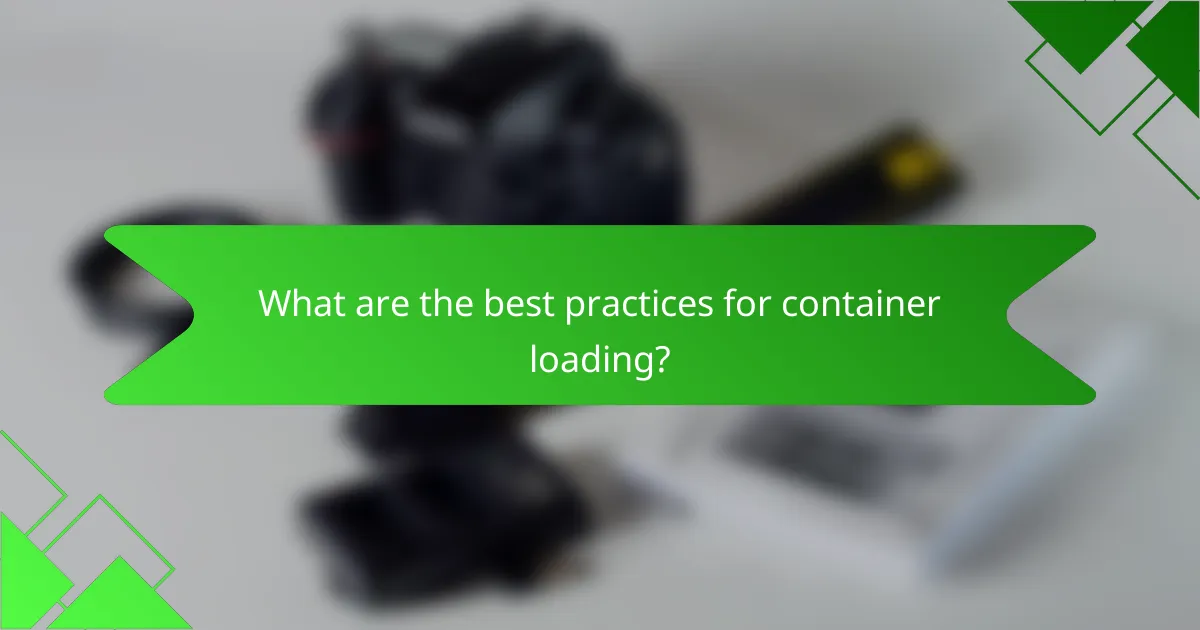
What are the best practices for container loading?
Best practices for container loading focus on ensuring safety, efficiency, and compliance. Proper techniques can minimize damage during transport, optimize space, and adhere to regulations.
Weight distribution techniques
Effective weight distribution is crucial for maintaining balance during transit. Load heavier items at the bottom and distribute weight evenly across the container to prevent tipping. Aim for a center of gravity that is low and centered.
Consider using a weight distribution calculator to assess load placement. This can help identify potential issues before loading begins, ensuring a safer transport process.
Maximizing space utilization
Maximizing space in a container involves strategic packing to reduce empty gaps. Use modular packing techniques and stack items to utilize vertical space effectively. Consider the dimensions of each item and how they can fit together like a puzzle.
Employing collapsible containers or flexible packaging can also help in optimizing space. Always measure the container’s internal dimensions and compare them with your cargo to ensure an efficient fit.
Load stability methods
Ensuring load stability is essential to prevent shifting during transport. Use dunnage, straps, and braces to secure items in place. This minimizes movement and potential damage to goods.
Regularly check the load throughout the journey, especially during stops. Adjustments may be necessary to maintain stability as the cargo settles or shifts slightly.
Proper packing materials
Selecting the right packing materials is vital for protecting goods. Use cushioning materials like bubble wrap, foam, or air pillows to absorb shocks. Ensure that boxes are sturdy enough to withstand stacking and transport stresses.
Consider the nature of the items being shipped; fragile items may require additional padding or specialized containers. Always label packages clearly to indicate handling instructions.
Compliance with regulations
Compliance with shipping regulations is critical for avoiding fines and delays. Familiarize yourself with international shipping standards and local regulations regarding weight limits, hazardous materials, and documentation requirements.
Ensure that all necessary paperwork is completed accurately and that the cargo adheres to safety guidelines. Regularly review updates to regulations to stay compliant and avoid potential issues during transit.
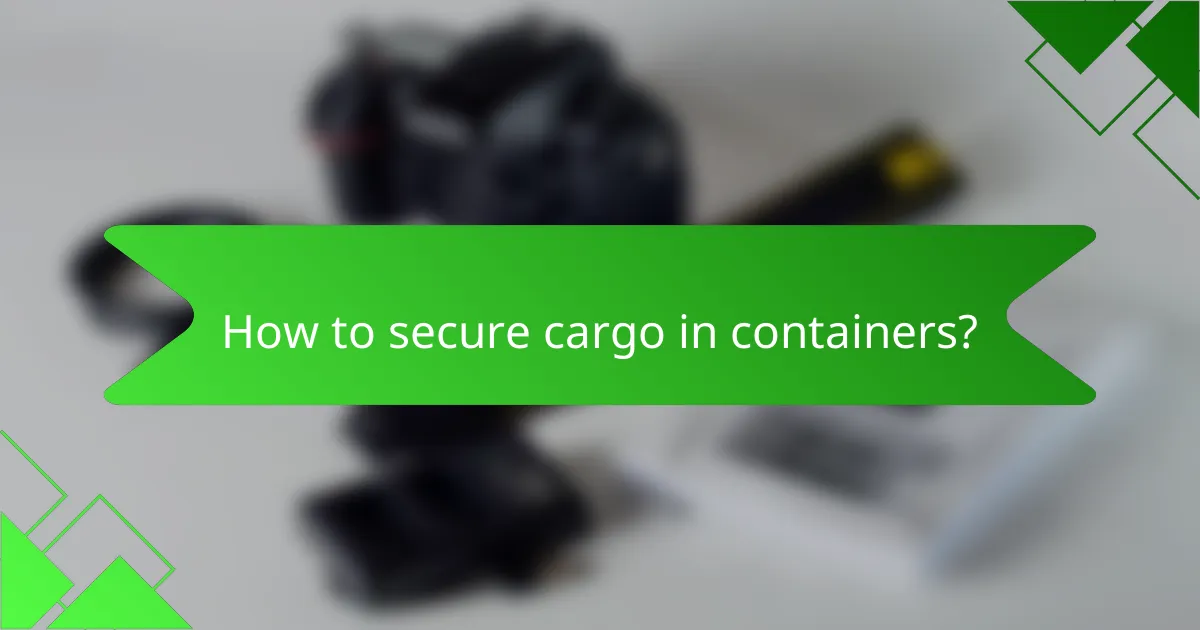
How to secure cargo in containers?
Securing cargo in containers is essential to prevent damage during transit. Effective methods include using cargo straps, dunnage bags, and implementing blocking and bracing techniques to ensure stability and safety.
Using cargo straps
Cargo straps are vital for securing items within a container. They come in various types, such as ratchet straps and cam buckle straps, and are designed to hold cargo tightly in place. When using cargo straps, ensure they are rated for the weight of the cargo and are properly tensioned to avoid slippage.
To maximize effectiveness, position the straps over the heaviest parts of the cargo and avoid sharp edges that could cause wear. Regularly inspect straps for signs of wear and replace them as needed to maintain safety standards.
Employing dunnage bags
Dunnage bags are inflatable bags used to fill voids between cargo items, preventing movement during transport. They are particularly useful for securing lighter items or when there are irregular shapes in the load. When using dunnage bags, inflate them to the appropriate pressure to ensure they provide adequate support without over-inflating.
Consider the size and shape of the cargo when selecting dunnage bags, as proper fit is crucial for effectiveness. Always check for punctures or leaks before use to ensure they perform as intended.
Implementing blocking and bracing
Blocking and bracing involves using wooden blocks, wedges, or other materials to create a secure environment for cargo. This method prevents movement by physically restricting the cargo’s ability to shift during transit. When implementing blocking, ensure that blocks are securely fastened and positioned to absorb any potential impact.
Use a combination of blocking and bracing techniques tailored to the specific cargo type and container dimensions. Regularly inspect the setup during loading and before departure to confirm that everything remains secure and stable throughout the journey.
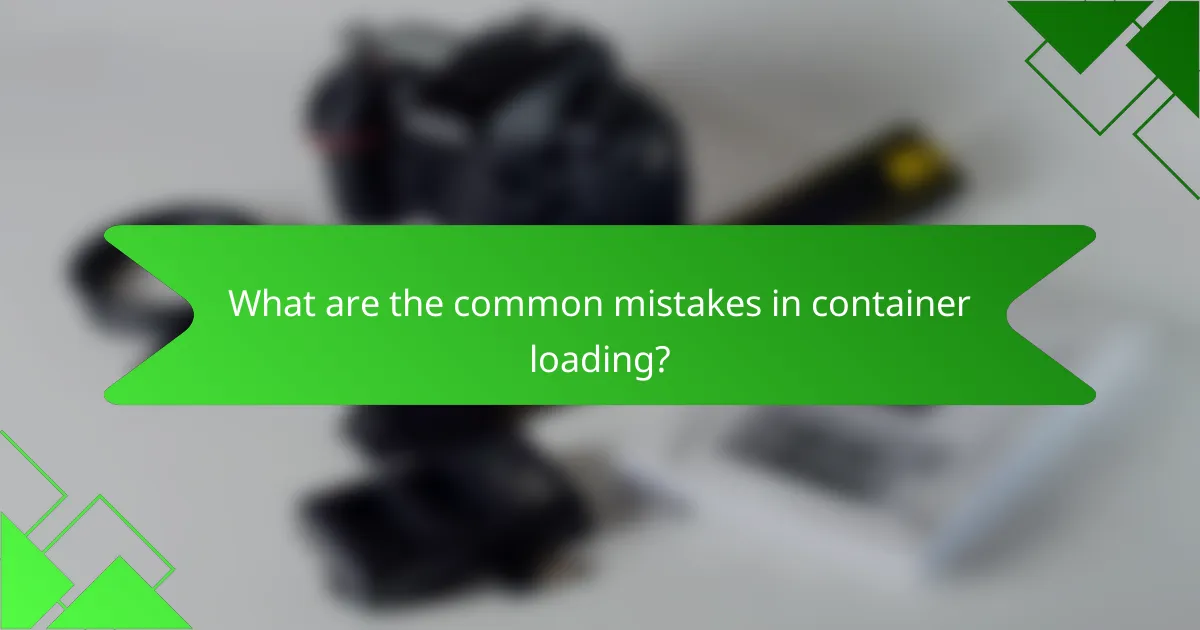
What are the common mistakes in container loading?
Common mistakes in container loading include overloading containers, poor weight distribution, and ignoring cargo securing methods. These errors can lead to safety hazards, damage to cargo, and increased shipping costs.
Overloading containers
Overloading containers occurs when the weight of the cargo exceeds the container’s maximum capacity. This can result in structural damage to the container and increased risk of accidents during transport. Always check the container’s weight limit, which is typically specified in the shipping documents.
To avoid overloading, weigh your cargo before loading and ensure it falls within the recommended limits. A good practice is to leave a buffer of around 10% below the maximum weight to account for any discrepancies.
Poor weight distribution
Poor weight distribution refers to uneven loading of cargo within the container, which can lead to tipping or shifting during transit. Proper weight distribution is crucial for maintaining stability and balance. Aim to distribute weight evenly across the container floor and keep heavier items at the bottom.
To achieve optimal weight distribution, consider using a loading plan that outlines the placement of each item. This can help prevent potential damage and ensure safe handling during transport.
Ignoring cargo securing methods
Ignoring cargo securing methods can lead to cargo shifting, which may cause damage or accidents. Proper securing techniques, such as using straps, dunnage, and blocking, are essential to keep cargo in place during transit. Always follow industry standards for securing cargo to minimize risks.
Utilize a combination of securing methods based on the type of cargo and its dimensions. Regularly inspect securing devices for wear and tear, and replace them as needed to maintain effectiveness.
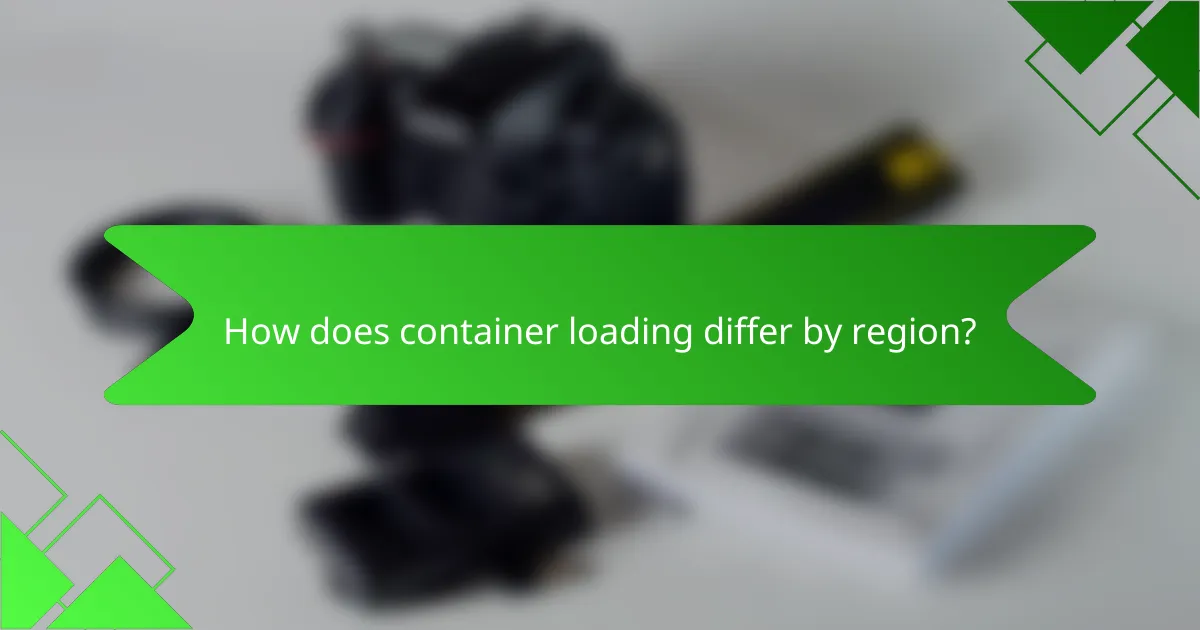
How does container loading differ by region?
Container loading practices vary significantly by region due to differing regulations, standards, and logistical considerations. Understanding these regional differences is crucial for ensuring compliance and optimizing shipping efficiency.
North America regulations
In North America, container loading is heavily influenced by regulations set forth by the Federal Maritime Commission (FMC) and the International Maritime Organization (IMO). Key considerations include weight limits, which typically range from 28,000 to 30,000 pounds for a standard 20-foot container.
Shippers must ensure proper weight distribution to prevent cargo shifts during transit. It is advisable to use load distribution software to verify that weight is evenly spread across the container’s floor. Additionally, securing cargo with appropriate materials, such as straps and dunnage, is essential to comply with safety standards.
European Union standards
The European Union has established stringent standards for container loading, primarily governed by the SOLAS (Safety of Life at Sea) convention. This includes the mandatory weighing of containers before loading, known as the Verified Gross Mass (VGM) requirement.
Shippers in the EU must ensure that the total weight of the container does not exceed 24,000 kilograms for a 20-foot container. It is crucial to document the VGM accurately and submit it to the shipping line prior to departure. Failure to comply can result in delays and additional costs.
Asia-Pacific practices
In the Asia-Pacific region, container loading practices can vary widely, influenced by local regulations and infrastructure capabilities. Countries like China and Japan have specific guidelines that often emphasize the importance of efficient loading to maximize space and reduce shipping costs.
Common practices include the use of automated systems for loading and unloading, which can enhance accuracy and speed. Shippers should also consider local customs and port regulations, which may require specific documentation and adherence to weight limits that can differ from international standards.

What tools can assist in container loading?
Several tools can enhance the efficiency and safety of container loading. These tools include specialized software, weight scales, and load planning applications that help optimize the loading process and ensure compliance with regulations.
Container loading software
Container loading software streamlines the loading process by providing visual representations of how cargo should be arranged within a container. These programs can simulate weight distribution and help avoid overloading, which is crucial for safety and compliance with shipping regulations.
When selecting software, consider features such as user-friendliness, integration with existing systems, and the ability to handle various container sizes. Popular options include CargoWiz and LoadPlanner, which offer different pricing tiers based on functionality.
Weight scales
Weight scales are essential for verifying that the total weight of the loaded container does not exceed legal limits. Accurate weighing helps prevent penalties and ensures safe transport. Portable scales can be used at loading docks for convenience.
It’s advisable to use scales that comply with local regulations, such as the SOLAS (Safety of Life at Sea) convention, which mandates accurate weight declarations for containers. Regular calibration of scales is also recommended to maintain accuracy.
Load planning apps
Load planning apps assist in organizing cargo efficiently within a container. These applications allow users to input cargo dimensions and weights, generating optimal loading configurations that maximize space and minimize the risk of damage during transit.
When choosing a load planning app, look for features like drag-and-drop functionality, real-time updates, and compatibility with mobile devices. Some popular options include EasyCargo and LoadPlanner, which cater to different business sizes and needs.
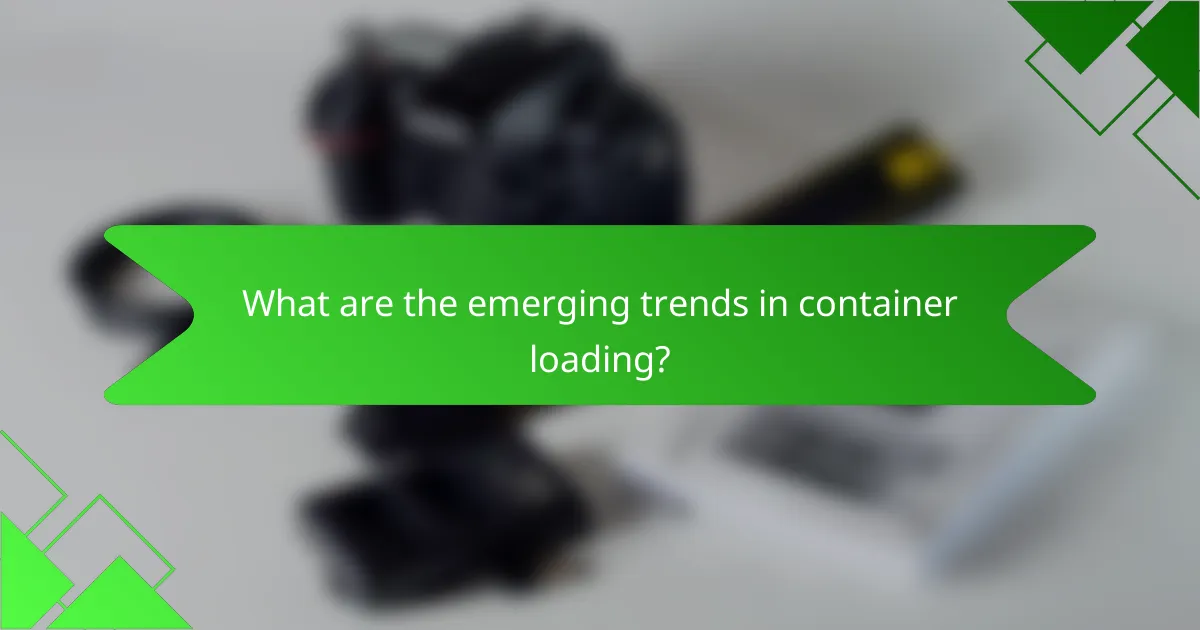
What are the emerging trends in container loading?
Emerging trends in container loading focus on enhancing efficiency and safety through innovative technologies and practices. Key developments include automation, data analytics, and sustainable practices that streamline operations while reducing costs and environmental impact.
Automation in loading processes
Automation in loading processes involves the use of technology to improve the speed and accuracy of container loading. Automated systems can include robotic arms, conveyor belts, and software that optimizes loading patterns based on cargo dimensions and weight distribution.
Implementing automation can significantly reduce labor costs and minimize human error. For instance, automated loading systems can achieve loading times that are 20-30% faster than manual processes, allowing for quicker turnaround in ports and warehouses.
When considering automation, it is essential to assess the initial investment versus long-term savings. Companies should also ensure that their workforce is trained to work alongside automated systems to maximize efficiency and safety.






